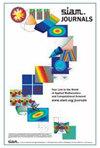用随机傅立叶特征模拟复杂动态模拟器
IF 1.9
3区 工程技术
Q2 MATHEMATICS, INTERDISCIPLINARY APPLICATIONS
引用次数: 0
摘要
SIAM/ASA 不确定性量化期刊》,第 12 卷,第 3 期,第 788-811 页,2024 年 9 月。 摘要:本文提出了一种基于高斯过程(GP)的方法来模拟复杂的动态计算机模型(或模拟器)。该方法依赖于模拟系统在初始(短)时间步上的数值流图,其中流图是描述系统从初始条件到下一时间步的后续值的演变的函数。这就产生了整个流图函数的概率分布,每次绘制都提供了流图的近似值。然后,根据马尔可夫假设,从仿真流图(即其后验分布)中抽取样本,并利用它从初始条件向前迭代,从而预测模型输出时间序列(根据马尔可夫假设)。多次重复这一过程,就会在时间序列上形成一个分布。该分布在特定时间点的均值和方差分别作为模型输出预测值和相关的不确定性。然而,考虑到 GP 后验样本的无限维性质,要绘制一个能代表整个领域的基础函数的 GP 后验样本在计算上是不可行的。为了克服这一限制,我们可以使用随机傅立叶特征(RFF)近似生成这样的样本。随机傅里叶特征是一种近似内核和生成 GP 样本的高效技术,既能提高计算效率,又能提供理论保证。所提出的方法被应用于模拟多个动态非线性模拟器,包括著名的 Lorenz 和 van der Pol 模型。结果表明,我们的方法具有良好的预测性能,相关的不确定性可以适当捕捉系统的动态。本文章由计算机程序翻译,如有差异,请以英文原文为准。
Emulating Complex Dynamical Simulators with Random Fourier Features
SIAM/ASA Journal on Uncertainty Quantification, Volume 12, Issue 3, Page 788-811, September 2024.
Abstract.A Gaussian process (GP)-based methodology is proposed to emulate complex dynamical computer models (or simulators). The method relies on emulating the numerical flow map of the system over an initial (short) time step, where the flow map is a function that describes the evolution of the system from an initial condition to a subsequent value at the next time step. This yields a probabilistic distribution over the entire flow map function, with each draw offering an approximation to the flow map. The model output time series is then predicted (under the Markov assumption) by drawing a sample from the emulated flow map (i.e., its posterior distribution) and using it to iterate from the initial condition ahead in time. Repeating this procedure with multiple such draws creates a distribution over the time series. The mean and variance of this distribution at a specific time point serve as the model output prediction and the associated uncertainty, respectively. However, drawing a GP posterior sample that represents the underlying function across its entire domain is computationally infeasible, given the infinite-dimensional nature of this object. To overcome this limitation, one can generate such a sample in an approximate manner using random Fourier features (RFF). RFF is an efficient technique for approximating the kernel and generating GP samples, offering both computational efficiency and theoretical guarantees. The proposed method is applied to emulate several dynamic nonlinear simulators including the well-known Lorenz and van der Pol models. The results suggest that our approach has a promising predictive performance and the associated uncertainty can capture the dynamics of the system appropriately.
Abstract.A Gaussian process (GP)-based methodology is proposed to emulate complex dynamical computer models (or simulators). The method relies on emulating the numerical flow map of the system over an initial (short) time step, where the flow map is a function that describes the evolution of the system from an initial condition to a subsequent value at the next time step. This yields a probabilistic distribution over the entire flow map function, with each draw offering an approximation to the flow map. The model output time series is then predicted (under the Markov assumption) by drawing a sample from the emulated flow map (i.e., its posterior distribution) and using it to iterate from the initial condition ahead in time. Repeating this procedure with multiple such draws creates a distribution over the time series. The mean and variance of this distribution at a specific time point serve as the model output prediction and the associated uncertainty, respectively. However, drawing a GP posterior sample that represents the underlying function across its entire domain is computationally infeasible, given the infinite-dimensional nature of this object. To overcome this limitation, one can generate such a sample in an approximate manner using random Fourier features (RFF). RFF is an efficient technique for approximating the kernel and generating GP samples, offering both computational efficiency and theoretical guarantees. The proposed method is applied to emulate several dynamic nonlinear simulators including the well-known Lorenz and van der Pol models. The results suggest that our approach has a promising predictive performance and the associated uncertainty can capture the dynamics of the system appropriately.
求助全文
通过发布文献求助,成功后即可免费获取论文全文。
去求助
来源期刊

Siam-Asa Journal on Uncertainty Quantification
Mathematics-Statistics and Probability
CiteScore
3.70
自引率
0.00%
发文量
51
期刊介绍:
SIAM/ASA Journal on Uncertainty Quantification (JUQ) publishes research articles presenting significant mathematical, statistical, algorithmic, and application advances in uncertainty quantification, defined as the interface of complex modeling of processes and data, especially characterizations of the uncertainties inherent in the use of such models. The journal also focuses on related fields such as sensitivity analysis, model validation, model calibration, data assimilation, and code verification. The journal also solicits papers describing new ideas that could lead to significant progress in methodology for uncertainty quantification as well as review articles on particular aspects. The journal is dedicated to nurturing synergistic interactions between the mathematical, statistical, computational, and applications communities involved in uncertainty quantification and related areas. JUQ is jointly offered by SIAM and the American Statistical Association.
 求助内容:
求助内容: 应助结果提醒方式:
应助结果提醒方式:


